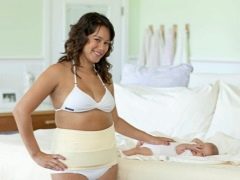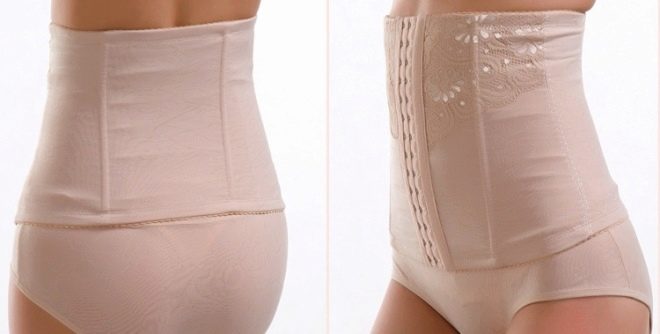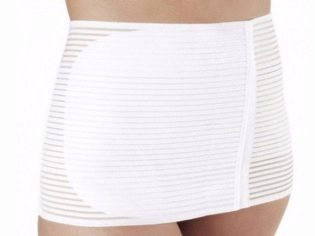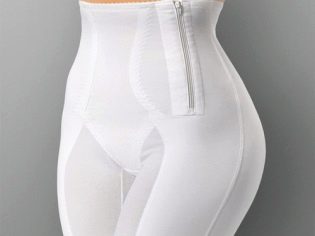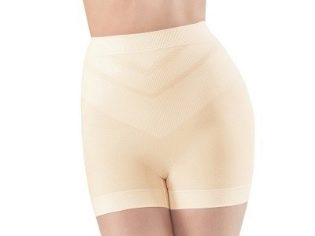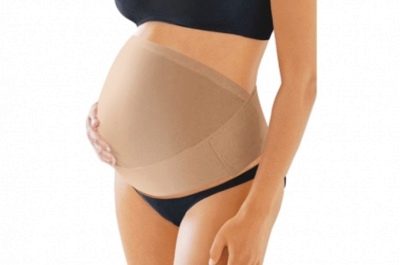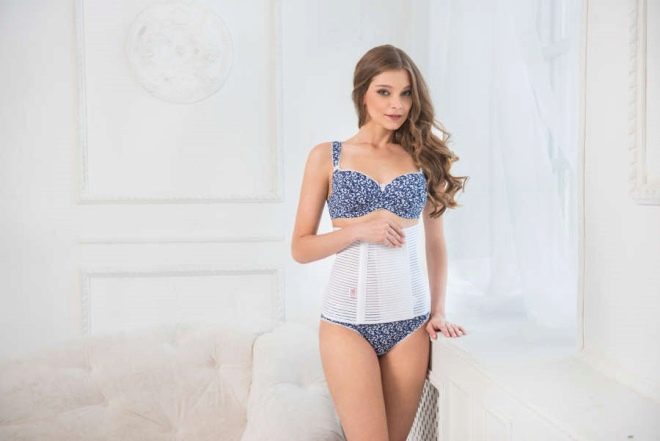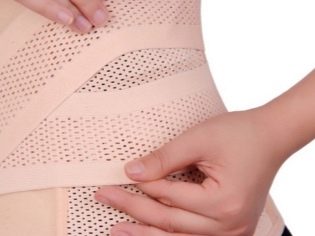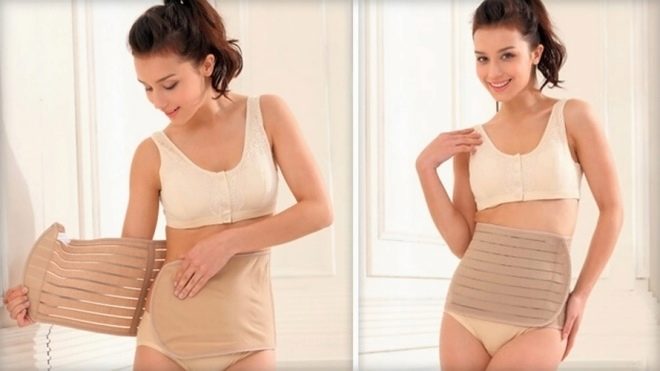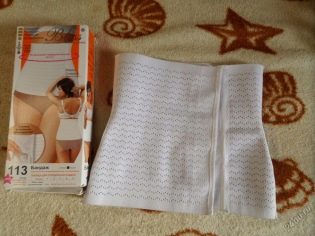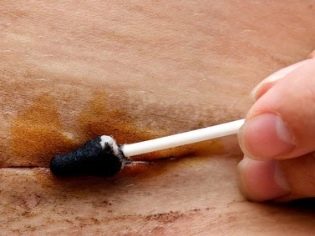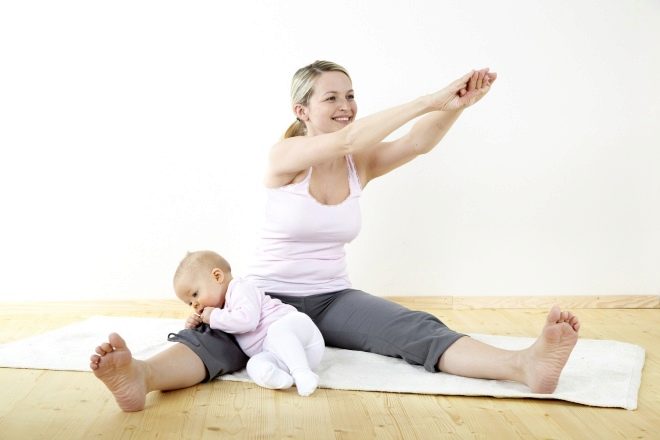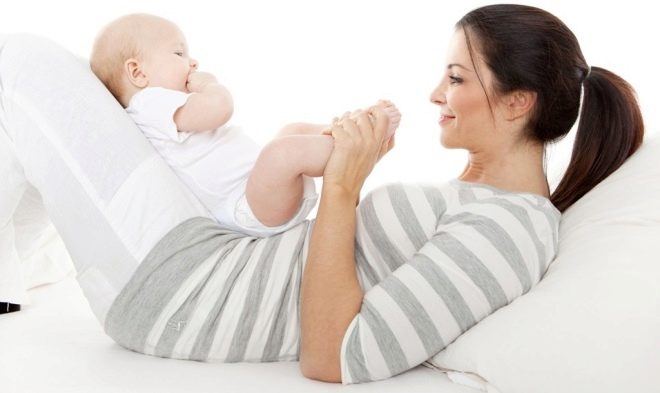Postoperative bandage after cesarean section
Deliveries by caesarean section today are quite common in obstetric practice. Just about one in five little Russians is born that way. Together with the recommendations to refrain from lifting weights, to eat properly, to strictly adhere to moderate physical activity, the woman who gave birth before being discharged from the maternity hospital can receive and advice from professionals to use a bandage.
In this material, we consider what type of product is needed after a cesarean section, why it is needed, what are the features of the choice and how to wear it so that there is maximum benefit, and there is no harm at all.
Product
Surgical birth from physiological differ radically. During caesarean section, the baby is born not through the genital tract, as provided by nature, but through an incision made by the surgeon’s scalpel on the uterus and on the anterior abdominal wall. The operation involves dissecting not only the skin and the uterine wall, but also the muscular and fatty layers. After the birth of the baby and the separation of the placenta, the surgeon manually stitches all the incisions made before. The types of sutures and types of suture material are different.
After a cesarean section, the recovery period is quite complicated and long. The uterus contracts more slowly, the skin on the abdomen remains stretched longer, the inner and outer sutures heal up to 2 months, after which the formation of the inner scar on the uterus continues (the process is finally completed only two years after the operation). therefore the postoperative period does not imply heavy physical exertion, playing sports, or lifting weights.
Relieve the load on the healing muscles of the abdomen helps a special orthopedic device - a bandage. It supports the muscles, easily tightens the skin, fixes a sterile bandage on the outer seam, if you start to wear a bandage in the early postpartum period before the sutures are removed. All this in a complex helps to reduce the discomfort, which is closely related to the first weeks after cesarean, to reduce pain, aching in the lower back.
When it comes time to start walking, moving, caring for a baby, many moms who have undergone surgery, implicitly hold the belly with a hand - this gesture is often unconscious, because the body clearly understands, so in this situation it will be easier and safer. The bandage, in fact, is exactly the same support.
Wearing a bandage after a delivery operation is not considered mandatory, it is only a recommendation. But many obstetricians recommend this adaptation to their patients with a view to the future: it has been proven that women who wore after a cesarean bandage restore their physical form more quickly, their uterine contractions go faster, they rarely go to the doctor for postoperative complications such as adhesions, cicatricial hernia and fistula.
Indications and contraindications
Any puerperal who has a caesarean section can recommend the bandage, but women are more likely to face certain problems that make the rehabilitation period more difficult. These problems include:
- diseases, deformities, injuries of the musculoskeletal system (especially of the spine);
- hypotension or uterine atony (lack of full contractions that lead to involution of the reproductive organ, or the complete absence of weak contractions);
- high muscle tone of the spinal and abdominal muscles (this can occur in patients, before the onset of "interesting position" involved in professional sports);
- obesity, excess weight, large weight gain, big belly, its sagging;
- pulling pains in the operated area, creating difficulties in movement.
The bandage promotes recovery, it can be used to remove the stomach, it makes a woman more mobile and mobile. And although such an orthopedic "helper" is not necessary, many women, and without the above indications, are inclined to buy it.
It is important to talk with the doctor who is watching you, he will be able to give an exact answer to the question of whether the product is necessary and in what mode to use it.
Like any orthopedic device, postoperative abdominal bandage is not always shown. So, you should not use it for puerperas with:
- signs of inflammation of the postoperative suture, suppuration, separation from the region of the rumen of the blood;
- signs of swelling of the scar;
- acute pain in the lower abdominal area and in the back;
- with previously installed pyelonephritis;
- with violations in the digestive tract (diarrhea, bloating, constipation);
- propensity to inadequate immune allergic reaction to the material from which the product is made.
In these cases, you will certainly need to consult a doctor, and for the most part any contraction of the abdomen is absolutely contraindicated.
Varieties of products
Postoperative bandage is a rather broad concept. It includes a number of products that differ not only in size and price, but also in different degrees of support for completely different muscle groups. So, a large orthopedic salon will be able to offer a choice of several types of bandages.
Corset - These are tall pants with solid elements that can be adjusted depending on which part needs to be supported more. Effectively holds the region of the lower abdominal muscles of the aponeurosis and lower back. Suitable for women with spinal problems.
- Belt bandage - very simple in design. It is a wide belt that supports the lower abdomen (usually the most problematic place after a cesarean section). A clear plus is relatively low cost. The obvious disadvantage is the inconvenience of wearing. Belt band may move out, loosen when moving.
- "Skirt" - an improved version of the waist product, only the area itself is wider, solid elements are added, due to which the bandage is not weakened, it fixes the stomach and sides well.
- Tights ("Bermuda") - it is a supporting device in the form of tight shorts, which fixes not only the lower back and abdomen, but also the hips (which is also important for a woman who wants to get in good physical shape after childbirth).
- Universal bandage panties with the highest fit. Well fixes and muscles of the back and abdomen. It is possible to wear it under normal clothes.
The product, which the lady may have put on in the late stages of pregnancy for holding the abdomen, is not suitable after the operation. For pregnant women, products are made in such a way that they support the womb and ligaments, making it easier for the legs. In the rehabilitation period, the puerperal woman needs another support - to reduce the load on the abdominal muscles and lower back.
From the list above, it is possible to choose any product, starting from the extent of their problem, from their feelings. If in doubt, you can always consult a doctor who can orient the patient to a particular model.
How to make a choice?
Which bandage is better to choose depends on the build of the woman, on the time of year and the type of operation she has performed. So, with a fairly common horizontal section in the lower uterine segment, you can use almost any model. And for corporal dissection of the abdominal wall (vertical incision from the navel to the pubis), you will need a product with reliable fixation of the entire abdominal wall, and not just its lower part (aponeurosis).
When choosing a product, be sure to try it on. To make the right choice, you need to consider the following points.
- The fastener or fixing tab of the bandage should be positioned so that a woman at any time can get to her simple and easy access if you need to urgently weaken or tighten the degree of fixation.
- If summer is hot in the yard, then it is better to stop the choice on belt products, since more closed ones (for example, Bermuda shorts) may restrict fresh air access to the postoperative suture area, which can cause inflammation and infection of the latter.
Please note that the figure of the woman will change, and it is possible that this will happen pretty quickly, and therefore the bandage, which will become great, will be completely useless. To choose the size correctly is to take the product 1-2 sizes smaller than the one that the woman currently has.
- Among the variety of models, it is always better to give preference to those that have additional side solid insert strips.
- Pay attention to the material - it is important that your bandage does not become a “greenhouse” for the postoperative scar area, the skin under it must “breathe”. For this purpose, it is reasonable to leave your choice on lycra, polyester, microfiber or cotton.
Particular importance is given to the type of fastener. You may be offered a bandage with laces, hooks and buttons, but the best choice is considered to be the choice on the velcro. It is easy to adjust and simply change the degree of contraction, if the puerperal has not calculated and fixed the stomach too tightly or weakly.
You also need to examine the state of the internal seams on the product - they should be soft, neat, small, so as not to rub the skin and not cause infection in the place of violation of the integrity of the skin.
Doctors advise to take into account the type of figure. A woman with a waist spreading out after pregnancy will not be too comfortable to wear high corsets that cover a large space. And those who have a very big belly (for example, after giving birth to twins or triplets), should focus on models with wide solid elements along the line of the abdomen and in the hips.
Remember that the bandage should not rub or compress the area of the postoperative scar.
How to use?
It is also necessary to wear the chosen bandage correctly, otherwise a useful orthopedic device will not help, but will only harm the newly made mother. Here are the basic rules for wearing a bandage after cesarean section.
- The bandage can be used from the first day after the operation, but in the first 5-6 days it is necessary to put on the product only when the woman is going to walk, move. The rest of the time you should do without it. To lie in a bandage just should not.
- After discharge from the maternity hospital, wearing a bandage at home should be increased gradually, by 1-2 hours per day. The maximum time that a woman can spend in an orthopedic product per day is 10 hours.
- Wearing the product for the first time will help the medical staff of the hospital. If the first fitting is for the period of home stay, you need to lie on the bed on your back, put on the product, fix the necessary muscle groups in a comfortable position, and only after that stand upright on your feet. This rule will apply throughout the life of the product.
It is strongly not recommended to wear it standing, sitting or in some other body position in space - fixation will not be anatomically correct.
- Sleeping in a bandage is strictly prohibited. At night, the product must be removed.
- Do not wear the product without interruption. After 3-4 hours of use, it makes sense to take a break for 30-40 minutes, after which you can put on the bandage again.
- At the early stage of rehabilitation after removing the bandage, it is imperative to dry the skin in the postoperative scar area with hydrogen peroxide and process the skin around the cutting room with green paint. This will help avoid complications, inflammation, bacterial infection.
- The degree of tension may be different, but too tight dragging is dangerous, and this should not be forgotten. It disrupts blood circulation, scar healing is more slow, it is possible the occurrence of problems with internal organs in the constricted part of the body. After the bandage is put on, it should be checked whether he is sitting tight. To do this, enter a palm under it. It should go right next to it. If it passes easily, the bandage is weak; if it does not pass, it is put on and tightened too tight.
If you find suppuration, bleeding in the area of the scar, wetting or the formation of cones, you should immediately remove the bandage and consult a doctor for further examination and treatment.
Care of the bandage should be delicate. Wash the product is allowed only in warm water and only by hand. Liquid or regular soap may be used as a detergent. It is impossible to squeeze, twist the washed thing, it can damage the hard inserts. Wet bandage immediately hang over an empty basin or bath. It dries naturally. From this point of view, it will be reasonable to purchase two products, if the family budget allows. While one dries after washing, the second can be safely worn.
When the need for bandage disappears?
This is another very exciting women issue. From the point of view of medicine and the changes that occur in the woman's body after a cesarean section, the need for wearing the product is no longer natural due to 3-4 months after delivery, because the process of restoring the integrity of internal tissues and the external scar is completed by this date .
If a woman during this period decides to do gymnastics for weight loss, then you can continue to put on a bandage during classes, because the restoration of the muscle tissue and nervous sensitivity cut by the surgeon ends later.
It is possible to wear a bandage for up to a year, but it should be understood that the postoperative “supporter” by itself does not contribute to weight loss or the formation of a figure, and therefore there is no expediency in wearing it by and large.
Cost of
The cost of such an orthopedic assistive device depends on the brand of the manufacturer, on the materials, on where you buy the bandage. So, in online stores there are big discounts, but in a specialized orthopedic salon or in a pharmacy there is an opportunity to try on a product, although the prices for bandages are somewhat higher.
Bands of the waist type are the most affordable ones; their cost can start from 680 rubles. Products with a fairly reliable side and frontal support from solid inserts cost from 1500 rubles. Expensive models of the corset type with panties, in which everything is thought out to the smallest detail, cost 6,000 rubles and more.
Do not confuse bandage and underwearwhich unscrupulous sellers often position as its worthy replacement. Lingerie is a simple and easy way to make small adjustments to external body flaws.
Corrective panties or tights do not have any effect on deep muscle layers. When recovering from surgery, corrective underwear is completely useless.
Reviews of patients and doctors
Many women who used such products after the operation, note that it is best to buy two bandages - one with hard elements to wear after surgery, and the second, more elastic - for subsequent wear. At the same time, it is possible to achieve fairly quick results. According to the reviews of women left on thematic forums on the Internet, the figure after 4 months of wearing this device becomes better than before pregnancy.
The bandage greatly facilitates the task of walking in the first weeks, the discomfort (seam pulls, hurts) is almost indistinguishable, they argue.
But there are those who oppose such devices. According to reviews, it was inconvenient for them, it was difficult to breathe and get up and sit down, and even when walking, the bandage crashed directly into the postoperative scar, which caused discomfort and even pain.
Reviews of doctors about postoperative orthopedic products after interventions such as cesarean section are rather ambiguous. Some obstetricians support the desire of women to wear a bandage, while others oppose it, arguing that the muscles supported from the outside are artificially restored longer, “lazy,” and the seam heals worse. In some countries, for example, in Holland or Italy, wearing a bandage after cesarean section is generally prohibited, although wearing an analogous device, but for pregnant women, is widely supported.
To wear a bandage or not - it is up to the puerperal herself to decide. Doctors in the hospital have no right to insist, much less demand the purchase of such a product from the patient, as some moms tell in their responses. This is an entirely voluntary matter. The exception is complex rehabilitation cases, which were discussed above.
About the bandage before and after childbirth, as well as how to properly wear it, see the following video.
